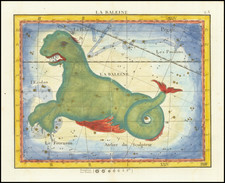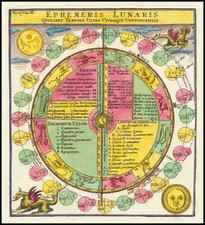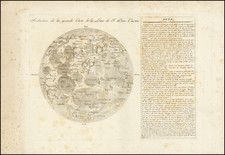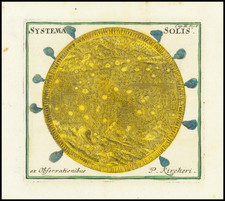A rare star chart centered on the constellation Cancer, the crab. Cancer is sometimes referred to as the most humble constellation, lacking many of the great creation stories of the other constellations. In Greek mythology, Cancer is the crab that pinched Hercules in the foot and was subsequently stepped on during a fight with Hydra. Hera, enemy of Hercules, ascended Cancer into the stars for this feat. Cancer used to be in eclipse during the June solstice during antiquity, which is why it bestows its name on one of the tropics.
The chart includes a colored Cancer and uncolored parts of the constellations of Leo, Argo, Canis Minor, Monoceros, Gemini, and others. Major stars are shown according to brightness and heightened in gold. The image is orientated so that the ecliptic line lies horizontally. Several other lines of celestial importance are shown.
This chart was dedicated to "The Reverend Francis Hooper D.D., Senior Fellow of Trinity Colledge Cambridge" and a coat of arms reads "Post Funera Virtus," or "virtue after death." Hopper left several marks on his college, including dedicating an estate at Barrington to a grant for English students, helping to rebuild Trinity bridge, and leaving a fund to construct a new combination room. He is remembered with a bust in Trinity Chapel.
John Bevis (1695-1771) was an Oxford-trained physician and amateur astronomer, who is perhaps best known for his discovery of the Crab Nebula in 1731, 27 years before Charles Messier's re-discovery. Bevis set up a private observatory in North London in 1738, where he made observations, which led to his attempt to create the second British Celestial Atlas. In the mid 18th Century, Bevis produced his Uranographia Britannica, which was the first major celestial atlas published after the posthumous publication of the Atlas of John Flamsteed, England's first Royal Astronomer.
Although many astronomers praised the Flamsteed atlas for its accuracy, others were unhappy with the unwieldy size and inelegant plates. This dissatisfaction resulted in John Bevis's decision to base his work on Bayer's Uranometria, rather than Flamsteed. Bevis succeeded in having the plates engraved for his atlas with the assistance of publisher John Neale, but Neale's bankruptcy prevented publication of the Atlas, although a star catalog was printed.
The bankruptcy of Neale resulted in the plates being sequestered by the courts, and the Bevis Uranographia, as it was to have been called, was not published until 1786, some 15 years after his death, and then only as part of composite atlases. Fortunately, a number of impressions were printed from the plates before they disappeared, and nearly all of these sixteen pre-publication sets are still preserved in various libraries around the world.
When one compares the Bevis atlas to Bayer's Uranometria, it is apparent that Bevis followed the plan of the Bayer atlas exactly. There are the same number of plates, of the same size, and each covers the same area of the sky. The constellation figures are also stylistically identical. But the two are not the same. Bevis has more stars, and more accurate positions for those stars. He also took pains to include the many new or variable stars that had been recently discovered, as well as the nebulous objects. There are in fact nine Messier objects on the Bevis charts (including M1, which Bevis discovered), and five of them had never before appeared in a star atlas.










![[ Lupus and Centaurus ] (Stars Heightened in Gold)](https://storage.googleapis.com/raremaps/img/small/83187.jpg)



![(Hyginus's Astronomy) De mundi et sphaerae ac utriusque partium declaratione cum planetis et varijs signis historiatis [Clarissimi Hyginii Astronomi]](https://storage.googleapis.com/raremaps/img/small/89256.jpg)